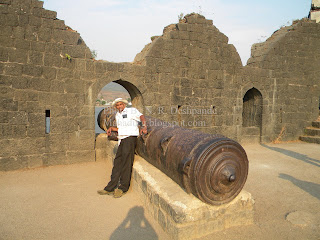Murud Janjira the robust fort is situated on the west coast of India. It is in Raigad District of Maharashtra, about 165km south of Mumbai.
The special thing about the fort is that, the fort was invincible to Marathas, Dutch and the British. All these tried to conquer the fort many times, but all the attempts were in vain. The robust fortress which is standing tall even after more than 400 years of construction, the cannons and the bastions of the fort has made the fort unconquerable.
In the 15th century the local fishermen had constructed some wooden structure on this island in the Arabian sea with the permission from Nizamshah of Ahmadnagar. This was done to protect the community from pirates. Ram Koli (Patil) was the leader of the fishermen community. Later he became rebel and refused to respect the orders of Nizamshah
One of the commander of Nizamshah, - Piram Khan captured the fort and the wooden construction from Kolis in Troy style. He entered the fort with three ships full of soldiers pretending to be a merchant. He offered Ram Patil and his men good quality wine. When all were under influence of the wine, Piraam Khan's soldiers came out of the ships and arrested Ram Patil. The fort was captured by Piram Khan. His son "Burhan Khan" constructed the fort which we see today. He razed the old construction by Kolis before constructing the new fortification with stone in about 1570. Since then the fort is impregnable.
Repeated attempts by Shivaji Maharaj to capture the fort failed. After him, Chhatrapati Smbhaji also could not capture the fort. So he build yet another marine fort : Padmdurg, just 9 km north to Janjira. Later Peshwas tried to capture Janjira, but failed.
The fort is about 3 km from the shore and can be approached by sailboats. As like other marine forts in Maharashtra, the main entrance is not visible unless the visitor comes enough close to the fort. The mosque, the palce of Siddi, the fresh water reservoirs, the cannons laying on the bastions of the fort are the things to be seen on the fort. Also there are other ruins of the buildings laying on the fort. The fortification of the fort is still in good condition as compared ti other forts in Maharashtra.
Here are some snaps of the impregnable fort : Janjira.
![]() |
| Fortification as seen from outside of Janjira |
![]() |
| Fortification as seen from outside of Janjira |
![]() |
| Main entrance of Janjira. This is not visible from along distance |
![]() |
| Main Entrance of the fort Janjira |
![]() |
| Remains of the construction inside the fort Janjira |
![]() |
| One of the cannon laying on the bastion of the fort Janjira |
![]() |
| One of the cannon laying on the bastion of the fort Janjira |
 |
| Fortification ans the sea as seen from iside the fort |
 |
| Sweet watre reservoir |
 |
| Ruins of the construction and the palace of Siddi |
 |
| Water reservoir and the palace of Siddi |
 |
| Cannons laying on one of the bastion of Janjira |
 |
| Sign inscribed in stone wall near main entrance |
 |
| Signs inscribed in stone wall near main entrance |
 |
| Singn inscribed in stone wall near main entrance |
 |
| Ruins of construction |
 |
| Cannon on the fort |
 |
| Main entrance from inside |



































